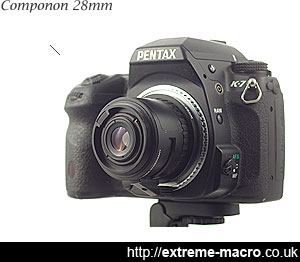Schneider Kreuznach Componon 28 mm f/4
by Johan J Ingles-Le Nobel
Last updated August 31, 2017
A fantastic lens to use for extreme macro focus stacking, the Schneider Kreuznach Componon 28mm f/4 is perhaps my personal all time favourite.
The Schneider Kreuznach Componon 28mm f/4 performs very well in a magnification range that many insect shots are taken and is very typical of the 6 element reversed enlarging lenses that work well for extreme macro.

Pentax K-7 with a reverse Componon 28mm f/4, shown without its usual hood, but with an annoying plastic tab that protrudes and can get in the way of a diffuser fitted over the lens. Part of the aperture mechanism, this tab can, thankfully, be quite easily removed using a small jeweller's screwdriver.
Colour fringing and flare are both minimal, the lens produces nice contrasty images and its pixel level detail and resolution wide open are outstanding. But, like any older lens, a hood over the end will help cut down on lack of contrast and overall greyness.
I highly recommend this lens; Componon 28mm is my extreme macro go to lens for 3:1 to 5:1.
About Componons
There are many ranges of Componon enlarger lenses used in extreme macro - from best to worst: APO Componon HM, G-Componon, Componon S and Componon.
The cheapest Componon already gives me excellent performance so I can only imagine what an APO Componon HM would produce. Componon 28mm is my extreme macro go to lens for 3:1 to 5:1
My Componon lens writeups are all concerned with the cheapest of the range. Regular Componons go between £50 and £100 on eBay; expect to pay north of £750 for an APO. My Componons all take a 43 mm adapter ring.
The Componon Body Shape
This tab can interfere with stacked adaptersOne of two things I dislike about Componons is their shape, with an aperture slider plastic tab that protrudes.
This tab can interfere with the sort of adapters we use like a step up or step down ring after the adapter on the reversed lens, and can also interfere with a diffuser if you support your diffuser on the lens itself like I sometimes do.
It means you have to cut a notch in the side of the diffuser to fit the tab through unless you take it off completely, as I have done.
The Componon Aperture Shape
The Componons I have all possess a very recognisable pentagonal star shaped highlight shape which I am really just not overly enthusiastic about personally.
very recognisable pentagonal star shaped highlight shape
However, this is not commonly a problem in extreme macro photography as the aperture shape is rarely seen. Older style Componons have a nicer aperture.
Componon 28 Best Setting
I have found my Componon 28mm to perform best wide open, ie at its f/4 setting. This is handy because it means that the batteries on your flash will last a little longer than on other macro lenses which need to be stopped down for their best setting.
Componon Controls
Componon 28mms have two controls that take a little getting used to. A preset ring allows you to preset the final aperture as selected through the green window, whereas an aperture setting slider allows you to adjust the aperture between wide-open, for focusing, and your chosen preset, for actually taking the image.
Componon 28mm f/4 Availability
Componon 28mms are often available through eBay. At the time of writing (2012), expect to pay up to £100 for a very good condition one, although it will usually be less. New APO Componons can be purchased through larger camera shops.
Componon 28 Working Distance
| Extension | Magnification | Working Distance |
| Reversed | 1.9 | 37mm |
| 25mm | 2.78 | 33mm |
| 50mm | 3.37 | 29mm |
| 90mm | 4.72 | 27mm |
Related Articles



